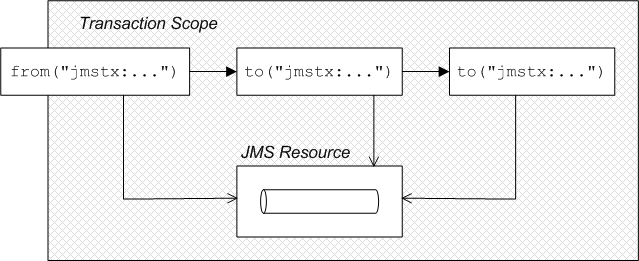Fuse 6 is no longer supported
As of February 2025, Red Hat Fuse 6 is no longer supported. If you are using Fuse 6, please upgrade to Red Hat build of Apache Camel.此内容没有您所选择的语言版本。
5.2. Demarcation by Transactional Endpoints
Overview
复制链接链接已复制到粘贴板!
If a consumer endpoint at the start of a route accesses a resource, the
transacted() command is of no use, because it initiates the transaction after an exchange is polled. In other words, the transaction starts too late to include the consumer endpoint within the transaction scope. The correct approach in this case is to make the endpoint itself responsible for initiating the transaction. An endpoint that is capable of managing transactions is known as a transactional endpoint.
Sample route with JMS endpoint
复制链接链接已复制到粘贴板!
Figure 5.2, “Demarcation by Transactional Endpoints” shows an example of a route that is made transactional by the presence of a transactional endpoint at the start of the route (in the
from() command). All of the route nodes are included in the transaction scope. In this example, all of the endpoints in the route access a JMS resource.
Figure 5.2. Demarcation by Transactional Endpoints
There are two different models of demarcation by transactional endpoint, as follows:
- General case—normally, a transactional endpoint demarcates transactions as follows: when an exchange arrives at the endpoint (or when the endpoint successfully polls for an exchange), the endpoint invokes its associated transaction manager to begin a transaction (attaching it to the current thread); and when the exchange reaches the end of the route, the transactional endpoint invokes the transaction manager to commit the current transaction.
- JMS endpoint with InOut exchange—when a JMS consumer endpoint receives an InOut exchange and this exchange is routed to another JMS endpoint, this must be treated as a special case. The problem is that the route can deadlock, if you try to enclose the entire request/reply exchange in a single transaction. For details of how to resolve this problem, see Section 3.3, “InOut Message Exchange Pattern”.
Route definition in Java DSL
复制链接链接已复制到粘贴板!
The following Java DSL example shows how to define a transactional route by starting the route with a transactional endpoint:
from("jmstx:queue:giro")
.to("jmstx:queue:credits")
.to("jmstx:queue:debits");
from("jmstx:queue:giro")
.to("jmstx:queue:credits")
.to("jmstx:queue:debits");
Where the transaction scope encompasses the endpoints,
jmstx:queue:giro, jmstx:queue:credits, and jmstx:queue:debits. If the transaction succeeds, the exchange is permanently removed from the giro queue and pushed on to the credits queue and the debits queue; if the transaction fails, the exchange does not get put on to the credits and debits queues and the exchange is pushed back on to the giro queue (by default, JMS will automatically attempt to redeliver the message).
The JMS component bean,
jmstx, must be explicitly configured to use transactions, as follows:
Where the transaction manager instance,
jmsTransactionManager, is associated with the JMS component and the transacted property is set to true to enable transaction demarcation for InOnly exchanges. For the complete Spring XML configuration of this component, see Example 3.1, “JMS Transaction Manager Configuration”.
Route definition in Spring XML
复制链接链接已复制到粘贴板!
The preceding route can equivalently be expressed in Spring XML, as follows:
transacted() not required
复制链接链接已复制到粘贴板!
The
transacted() DSL command is not required in a route that starts with a transactional endpoint. Nevertheless, assuming that the default transaction policy is PROPAGATION_REQUIRED (see Section 5.3, “Propagation Policies”), it is usually harmless to include the transacted() command, as in this example:
from("jmstx:queue:giro")
.transacted()
.to("jmstx:queue:credits")
.to("jmstx:queue:debits");
from("jmstx:queue:giro")
.transacted()
.to("jmstx:queue:credits")
.to("jmstx:queue:debits");
However, it is possible for this route to behave in unexpected ways—for example, if a single
TransactedPolicy bean having a non-default propagation policy is created in Spring XML (see the section called “Default transaction manager and transacted policy”)—so it is generally better not to include the transacted() DSL command in routes that start with a transactional endpoint.
Transactional endpoints
复制链接链接已复制到粘贴板!
The following Apache Camel components act as transactional endpoints when they appear at the start of a route (for example, if they appear in the
from() DSL command). That is, these endpoints can be configured to behave as a transactional client and they can also access a transactional resource.
